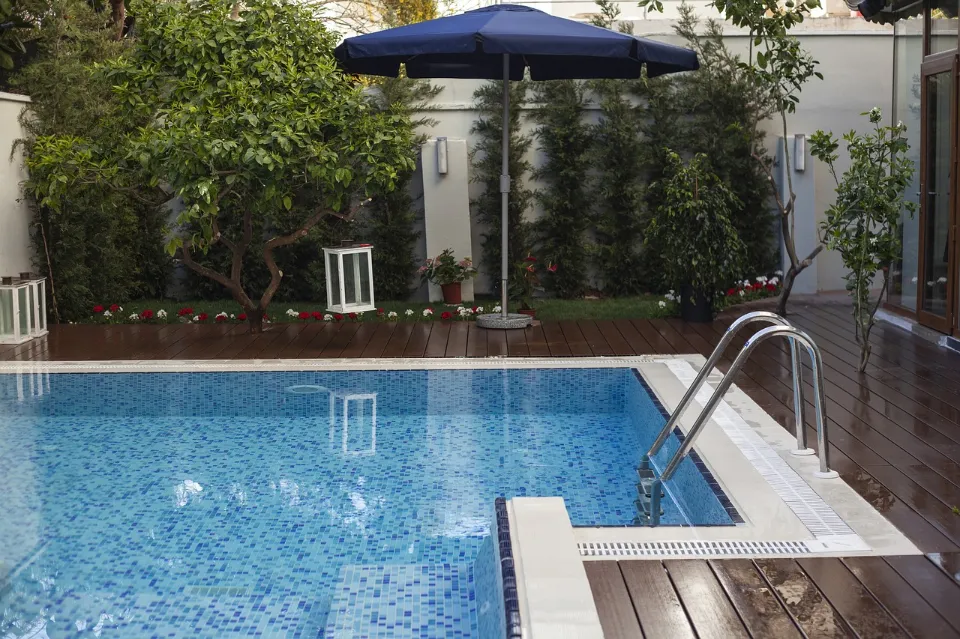How Much Sand Do I Need for a Swimming Pool – Tips & Suggestions
In comparison to in-ground pools, above-ground pools are easier and less expensive to install. But you must place a layer of sand between the pool floor and the pool lining in order to give you a cushioned surface under your feet and stop the pool lining from tearing.
The general rule is that an above-ground pool should have a two to three inch sand base. You should prepare to add about 100 lbs of sand to a 16-inch sand filter.
In this article, I’ll go over how much sand to use for your pool, how to figure out how much sand you’ll need, and which sand is best to use.
Why Do I Need Sand for An Above-Ground Pool?

There are a few crucial considerations despite the fact that installing an above-ground pool is simpler than installing an in-ground pool. A small, level area will need to be dug to accommodate the pool, and between the pool floor and the pool lining, a layer of sand will need to be filled in.
For an above-ground pool, sand is necessary because it safeguards the pool’s lining and offers a comfortable walking surface. Sharp rocks and gravel cannot rip the pool lining because of the sand layer. Additionally, it stops plants from growing through the lining.
To properly install an above-ground pool, the sand must be layered. You might have to spend thousands of dollars to fix leaks in your pool if this step isn’t done correctly.
Calculating the Amount of Sand Needed
It’s important to estimate how much sand you’ll need before you start buying it. Calculate your purchase of sand using the steps below.
Calculating Volume
Calculate the volume required to fill your pool with sand to a depth of at least 2 inches (5.08 cm) before anything else. Following are the volume calculation formulas.
For Round Pools
Area = π r2 h
Where r = radius and h = height
i.e. Area = 3.14 × r2 × h
For Rectangular Pools
Area = Length × Width × height
Using feet to measure each dimension will make it simple to calculate the volume.
Your height is 2 inches (5.08 cm) or 0.167 feet (0.05 m) tall in this location. Your desired sand layer thickness will determine this height. The minimum acceptable height is two inches (5.08 cm), but you are allowed to be as tall as six inches (15.24 cm).
I’ve provided a sample of the calculation below for a 15 x 30 foot (4.5 x 9.1 m) rectangular pool.
15 × 30 × 0.167 = 75.15 cubic feet (2.12 cu m.)
Convert to Cubic Yards Or Tons
Tones or cubic yards are typically used to calculate the amount of sand required.
The amount you calculated in the previous step should now be converted to cubic yards by dividing it by 27. This will provide you with the required amount of sand in cubic yards.
Additionally, you can determine how many tons the estimated amount of sand would weigh. Sand typically weighs 1.35 tons (1224 kg) or less.) per cubic yard. As a result, you can multiply the amount in cubic yards by 1.35 to get an approximate idea of how much sand is required.
Here are the calculations using the same example as before.
75.15 cubic feet ÷ 27 = 2.8 cubic yards (2.14 cu m)
Because of this, 2.8 cubic yards (2.14 cu m) of sand are required. To calculate the weight, multiply that by 1.35; the result is 3.78. This means that you will require almost 3 cubic yards (2.29 cu m) or 4 tons (3628 kg) of sand in total.
How Much Sand to Put in the Filter?
Here is a table showing the amount of sand that should be poured in each sand filter size. To easily determine how many pounds of sand to add, be sure to measure the diameter of your filter.
In most cases, sand filters have a 16-inch diameter minimum. You should prepare to add about 100 lbs of sand to a 16-inch sand filter. Add an additional 25 lbs of sand per inch of diameter over 16 inches until the diameter reaches 20 inches. Up until 24 inches, you add 50 lbs for every 2 inches in diameter starting at 20 inches. Up until you reach 27 inches, you add 50 lbs for every 3 inches starting at 24 inches. You’ll gain 150–200 pounds for every 3 inches above 27 inches. The biggest sand filters typically measure 36 inches.
Here is a helpful chart:
| Diameter of the Tank | Pounds of Sand to Add |
| 16 inches | 100 lbs |
| 18 inches | 150 lbs |
| 19 inches | 175 lbs |
| 20 inches | 200 lbs |
| 22 inches | 250 lbs |
| 24 inches | 300 lbs |
| 27 inches | 350 lbs |
| 30 inches | 500 lbs |
| 36 inches | 700 lbs |
There are some pool pump models for which this table does not apply. Some might have a little bit different volumes, and some will need more sand than others. As a result, always read the instructions before starting.
If all that math gives you the willies, use this calculator I made to determine how much sand to add based on the diameter of your tank.
Which Sand is Best for Your Pool?
You’ll need a soft and fine type of sand because the sand layer’s job is to prevent lining tearing. Selecting the right type of sand is crucial because ordinary beach sand and playground sand contain sharp rocks, and those won’t work.
The ideal pool sand is mason sand. It is also referred to as mortar sand or masonry sand. This sand is smooth and devoid of jagged rocks or gravel. Concrete sand is a suitable replacement for mason sand.
For your pool, it’s crucial to choose the best type of sand. In order to prevent the lining of your pool from being torn, it must be free of gravel, glass fragments, and sharp rocks. The best choice is something in the middle because some sands might be too fine. For your pool, concrete sand and mason sand are both the ideal size and consistency.

Where Can You Buy Sand for Your Pool?
You can purchase some sand once you’ve decided what kind and how much you require. The average weight of a bag of sand is 50 to 60 pounds. (22.7 kg.) and 100 lbs. (45.4kg.).
Most neighborhood hardware or gardening stores sell sand that you can purchase for your pool. Usually, this sand will be packaged in 50- to 100-pound bags (22.7 to 45.4 kg).). But if you require a lot of sand, you could contact a nearby landscaping or pool installation business to see if they will sell it to you by the truckload.
Simply purchasing the sand in bags from your neighborhood hardware store makes more sense for smaller pools. However, purchasing sand by the truckload might be more cost-effective if you require more than a ton of it.
Bottom Line
The quantity of sand required in a pool’s sand filter is frequently misunderstood by pool owners. If you follow the instructions carefully, your filter should function properly and catch all debris that passes through it. Most filters should be about two-thirds full, but depending on the diameter of your filter, you may need to buy additional sand to fill it completely. Plan accordingly, and your pool will sparkle all season. Pool filters may require anywhere from 100 pounds to 700 pounds of sand.
